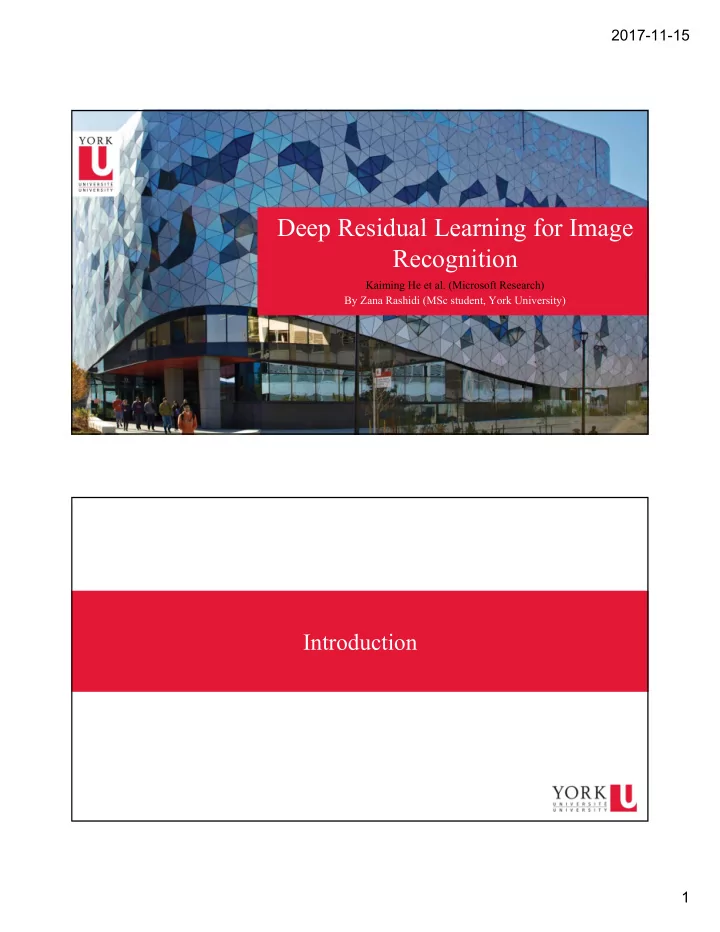

2017-11-15 Deep Residual Learning for Image Recognition Kaiming He et al. (Microsoft Research) By Zana Rashidi (MSc student, York University) Introduction 1
2017-11-15 ILSVRC & COCO 2015 Competitions 1st place in all five main tracks : • ImageNet Classification • ImageNet Detection • ImageNet Localization • COCO Detection • COCO Segmentation Datasets ImageNet COCO • 14,197,122 images • 330K images • 27 high-level categories • 80 object categories • 21,841 synsets (subcategories) • 1.5M object instances • 1,034,908 images with • 5 captions per image bounding box annotations 2
2017-11-15 Tasks Image from cs231n (Stanford University) Winter 2016 Revolution of Depth Image from author’s slides, ICML 2016 3
2017-11-15 Revolution of Depth Image from author’s slides, ICML 2016 Revolution of Depth Image from author’s slides, ICML 2016 4
2017-11-15 Example Image from author’s slides, ICML 2016 Background 5
2017-11-15 Deep Convolutional Neural Networks • Breakthrough in image classification • Integrate low/mid/high-level features in a multi-layer fashion • Levels of features can be enriched by the number of stacked layers • Network depth is very important Features (filters) 6
2017-11-15 Deep CNNs • Is learning better networks as easy as stacking more layers? • Degradation problem − With depth increase , accuracy gets saturated , then degrades rapidly, not caused by overfitting , higher training error Degradation of Deep CNNs 7
2017-11-15 Deep Residual Networks Address Degradation • Consider a shallower architecture and its deeper counterpart • Solution by construction : − Add identity layers to the shallow learned model to build the deeper model • The existence of this solution indicates that deeper models should have no higher training error , but experiments show: − Deeper networks are unable to find a solution that is comparable or better than the constructed one 8
2017-11-15 Address Degradation (continued) • So deeper networks are difficult to optimize • Deep residual learning framework − Instead of fitting a few stacked layers to an underlying mapping − Let the layers fit a residual mapping − Instead of finding the underlying mapping H(x) , let the stacked nonlinear layers fit F(x)=H(x)-x , so original mapping recasts into F(x)+x • Easier to optimize the residual mapping instead of the original Residual Learning • If identity mapping was optimal − Easier to push residual to zero − Than to fit identity mapping • Identity shortcut connections − Add to output of stacked layers − No extra parameters − No computational complexity 9
2017-11-15 Details • Adopt residual learning to every few stacked layers • A building block − y=F(x, W i )+x − x and y input and output − F(x, W i )+x is the residual mapping to be learned − ReLU nonlinearity Details • Dimensions of x and F(x) must be the same − Perform linear projection − y=F(x,W i )+W s x − 2 or 3 layers − Element-wise addition 10
2017-11-15 Experiments Plain Networks • 18 and 34 layers • Degradation problem • 34 layer has higher training (thin curves) and validation (bold curves) error than 18 layer network 11
2017-11-15 Residual Networks • 18 and 34 layer • Differ from the plain networks only by shortcut connections every two layers • Zero-padding for increasing dimensions • 34 layer ResNet is better than 18 layer ResNet Comparison ● Reduced ImageNet top-1 error by 3.5% ● Converges faster 12
2017-11-15 Identity vs. Projection Shortcuts - Recall y=F(x,W i )+W s x A. Zero-padding for increasing dimension (parameter free) B. Projections for increasing dimension, rest are identity C. All shortcuts are projections Deeper Bottleneck Architecture • Training time concerns • Replace residual blocks with 3 layers instead of 2 • 1 ✕ 1 convolution for reducing and restoring dimensions • 3 ✕ 3 convolution, a bottleneck with smaller input/output dimensions 13
2017-11-15 50 layer ResNet • Replace each 2 layer residual block with this 3 layer bottleneck block resulting in 50 layers • Use option B for increasing dimensions • 3.8 billion FLOPs 101 layer and 152 layer ResNet • Add more bottleneck blocks • 152 layer ResNet has 11.3 billion FLOPs • The deeper, the better • No degradation • Compared with state-of-the-art 14
2017-11-15 Results Object Detection on COCO Image from author’s slides, ICML 2016 15
2017-11-15 Object Detection on COCO Image from author’s slides, ICML 2016 Object Detection in the Wild https://youtu.be/WZmSMkK9VuA 16
2017-11-15 Conclusion Conclusion • Deep residual learning − Ultra deep networks could be easy to train − Ultra deep networks can gain accuracy from depth 17
2017-11-15 Applications of ResNet • Visual Recognition • Image Generation • Natural Language Processing • Speech Recognition • Advertising • User Prediction Resources • Code written in Caffe available in github • Third party implementations in other frameworks − Torch − Tensorflow − Lasagne − ... 18
2017-11-15 Thank you! 19
Recommend
More recommend